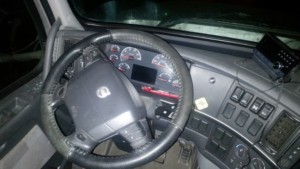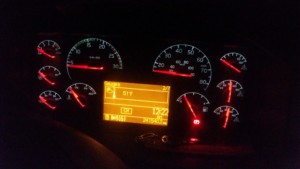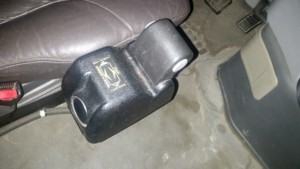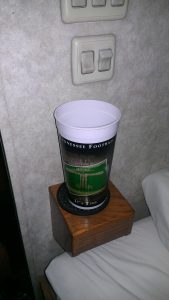Where did the name come from?
The Grey Ghost got its name from some neighbors, at the Escapees park just north of Knoxville a few years ago. The grey part should be pretty obvious if you look at a picture, and the ghost part comes from the fact that Dave has a habit of sneaking in under cover of darkness (eventually there will be a post about headlights to explain why). At least as sneaky as you can be idling a 15-liter turbodiesel and working the air brakes.
What is it?
Generally, the Grey Ghost is a type of motorhome referred to as a truck conversion. The cab and chassis were made by Volvo in Dublin, Virginia, and the house part was built by Showhauler in Middlebury, Indiana. The truck was built specifically for use as a motorhome, but other than a mile-long wheelbase, it’s not too different from a typical daycab semi tractor.
It was put together in 2004, and by the time Dave bought it, it had already logged 208,000 miles.
How does it compare to driving a “normal” motorhome?
That depends on the situation. For long days behind the wheel, it’s about as good as it gets. The driving position is very comfortable–not the super-plush motorhome seats, but firm, heated, air-suspended, and extensively adjustable Isringhausen seats that are still in like-new condition after almost a quarter-million miles.

The control layout and fit and finish is much more “car-like” than any class-A motorhome. And while not required in the US, Volvo crash tests its trucks and equips them with airbags. A structure engineered for a crash, with airbags, three point seat belts with pretensioners, and operable doors on both sides make it safer than the average home on wheels.

It’s definitely louder up front than a diesel pusher, but not in a bad way. It’s easy to have a conversation with whoever’s in the passenger seat, on the sofa, or back in the kitchen. Yet unlike a pusher, I can hear, see, and smell if or when something starts going wrong, and (hopefully!) do something before it becomes a major problem.

It has a fully automated 12-speed manual transmission (a two-pedal, brake and fuel), which means it acts a lot more like a semi getting going. It was made as part of a joint venture between ZF and Meritor, and is essentially the same as ZF’s AS-Tronic. By the time you’re up to 25 or 30 miles per hour, you’re already through 8 or so gears. It’s slower getting up to speed than a conventional slushbox since it has to cut power while changing gears, but it’s also more efficient and requires almost no maintenance. It’s also quicker than most of the American-made automated transmissions, skipping gears under lighter loads and easy terrain. Some versions of Eaton’s Ultrashift and Volvo’s I-Shift are other automated transmissions with similar functionality on newer trucks.
It’s size isn’t something you easily forget. It’s as long as the longest (legal) motorhomes at 45 feet, and about 13 feet tall. The front wheels are closer to the front than on most pushers, and the back wheels are further back (there’s a 40,000lb hitch back there)–making for a wheelbase that’s about 30 feet. Even with Volvo’s 50-degree wheel cut, it takes a lot of room to maneuver. One of the other drawbacks to this configuration–i.e. the hood out front–is that it can be harder to judge just where the front corners are (more on that later–cameras to the rescue!). Yet out on the road, that long wheelbase combined with a huge anti-sway bar means a more stable vehicle.

While it wasn’t done on purpose, I can demonstrate that it’s a pretty smooth ride.
Awesome. This must be a new addition. Great description of these Monster Trucks.